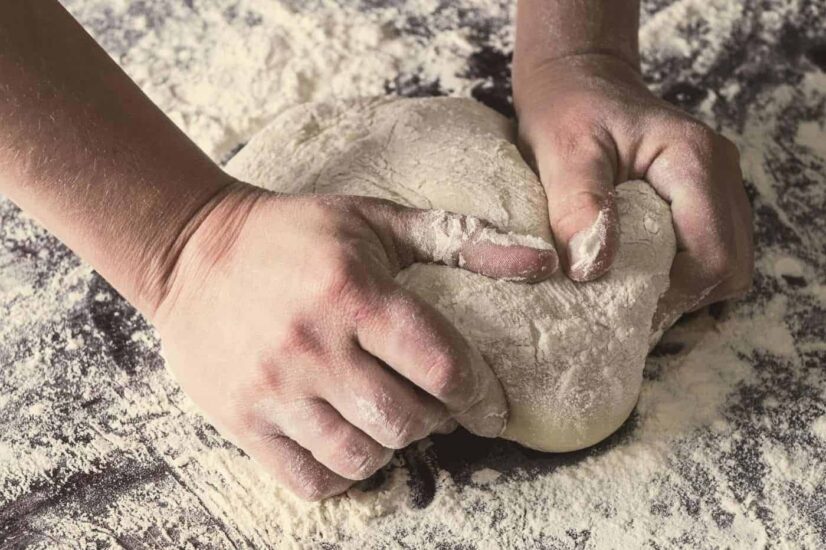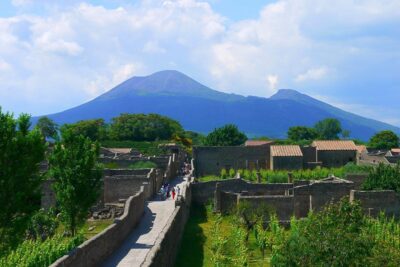Everyone is familiar with pizza but many do not know that, in addition to the famous Neapolitan pizza, one of the most popular local variants in Italy and around the world comes from the pleasant municipality of Tramonti, in the heart of the Lattari mountains.
What is its history? And what are the characteristics that differentiate the pizza of Tramonti from others? The story of the success of Tramonti’s pizza is not only the story of a gastronomic tradition, but above all a beautiful story of hope and a desire for social and economic redemption. Let us therefore discover the origins of pizza and the recipe currently handed down.
In Tramonti, the tradition of pizza has very ancient origins and is linked in particular to the cyclical production of bread in the domestic and rural ovens, with which the farmhouses of Tramonti are still dotted today. With the dough, originally made of flour from inferior cereals (rye, germanella, millet and barley), a kind of flatbread was prepared, eaten fresh from the oven and flavoured with herbs or at most a little lard.
As the centuries passed, pizza began to appear in bakeries, seasoned, this time, with tomato, oregano and anchovies, when available, or with ingredients brought from home, transforming the warm and fragrant bakery into a meeting place.
Indice dei contenuti
But how did this speciality spread around the world?
The now legendary story of the arrival of Tramonti’s pizza makers in northern Italy begins, according to most, when young Luigi Giordano, known as ‘Giggino ‘a casettara’, a soldier in Loreto di Novara in the early 1940s, discovered that no one in the north knew of and made mozzarella.
So, at the end of the Second World War, he decided, together with other fellow countrymen, to open a cheese factory in Oleggio to start producing it.
The mozzarella initially did not meet with much success, but Giggino did not give up and decided to open a pizzeria in Via Rosselli in Novara, where he used unsold mozzarella to garnish his pizzas.
It was 1951 and the Marechiaro pizzeria (this is the name of the pizzeria that is still active today), considered by many to be the first pizzeria in northern Italy, was the first of many businesses started by Giggino, who in the meantime had become ‘o milardario’. (The millionaire)
Thus began a great migration that saw men from Tramonti, followed closely by other citizens of the Amalfi Coast coming from the most diverse professions, first arriving in Piedmont and then in other regions ready to roll up their sleeves to pursue the dream of redeeming themselves from poverty thanks to the art of pizza.
Today, there are hundreds of Tramonti pizzerias in northern Italy and around the world and more than 3,000 pizza makers, many of them second and third generation, most of whom retain strong ties with their country of origin.
The municipal denomination (De. Co.) for the Pizza di Tramonti

Municipal denominations (De. Co.) are guarantee brands created following law no. 142 of 8 June 1990, which allows municipalities the power to regulate, within the principles of administrative decentralisation, on the subject of enhancing traditional agri-food activities.
On 26 April 2010, during the PastaTrend event in Bologna, the mayor Antonio Giordano, announced the conclusion of the procedure and therefore the recognition of the De.Co. Pizza di Tramonti. The municipality of Tramonti has therefore decided to establish this tradition and the characteristics of its pizza, which favours the use of selected local tomatoes, DOP Colline Salernitane olive oil and Fior di Latte di Tramonti mozzarella.
Here is the recipe according to the De. Co. ‘Pizza di Tramonti’ regulations.
Ingredients for the dough
To make a good dough, mix 1/3 OO flour, add purified water, salt and yeast. For 1 kg. of dough (to make 7 pizzas) you use
🔹 1 kg white or wholemeal flour (as traditionally found in Tramonti)
🔹 500 g water
🔹 10 g of salt
🔹 3 g of yeast (you can use sour dough called ‘criscito’ or alternatively beer yeast)
🔹 Wild fennel, if whole-wheat flour is used
Ingredients for seasoning

🔹 San Marzano tomatoes, in pulp or puree
🔹 ‘Fior di latte’ mozzarella (preferably from the Monti Lattari)
🔹 garlic
🔹 oregano
🔹 basil
🔹 extra virgin olive oil (preferably D.O.P. delle Colline Salernitane)
🔹 diced ‘piennolo’ tomatoes
Preparation
Once the dough has been made, it is left to rest for a few hours in a room that is neither too cold nor too hot. Then balls or loaves of about 180/200 grams each are prepared.
A single loaf is placed on a flat surface, previously sprinkled with flour (to prevent it from sticking) and spread out with the palm of the hand until a disc about 25/30 centimetres in diameter is obtained, which will be thinner in the centre than at the sides.
Once the disc of dough is rolled out, it is garnished and placed in a wood-fired oven at a temperature not exceeding 350 degrees for a few minutes. When it comes out of the oven, a drizzle of extra virgin olive oil is added.









